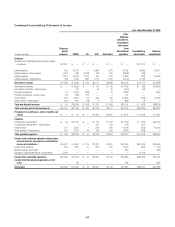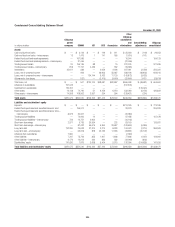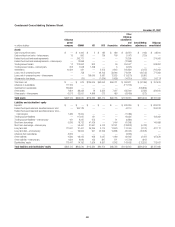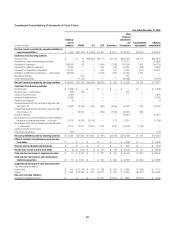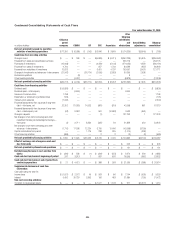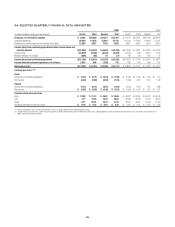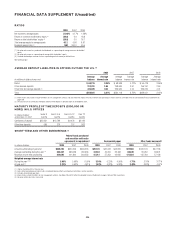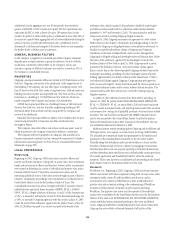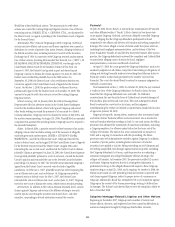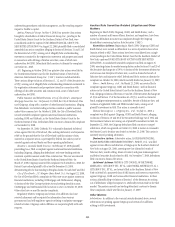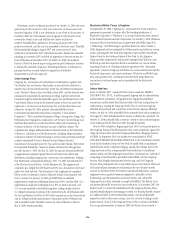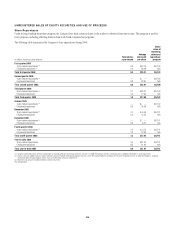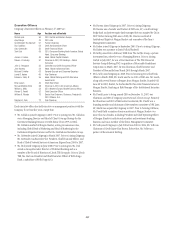Citibank 2008 Annual Report Download - page 233
Download and view the complete annual report
Please find page 233 of the 2008 Citibank annual report below. You can navigate through the pages in the report by either clicking on the pages listed below, or by using the keyword search tool below to find specific information within the annual report.LEGAL AND REGULATORY REQUIREMENTS
Bank Holding Company/Financial Holding Company
Citigroup’s ownership of Citibank, N.A. (Citibank) and other banks makes
Citigroup a “bank holding company” under U.S. law. Bank holding
companies are generally limited to the business of banking, managing or
controlling banks, and other closely related activities. Citigroup is qualified
as a “financial holding company,” which permits the Company to engage in
a broader range of financial activities in the U.S. and abroad. These activities
include underwriting and dealing in securities, insurance underwriting and
brokerage, and making investments in non-financial companies for a
limited period of time, as long as the Company does not manage the
non-financial company’s day-to-day activities, and the Company’s banking
subsidiaries engage only in permitted cross-marketing with the
non-financial company. If Citigroup ceases to qualify as a financial holding
company, it could be barred from new financial activities or acquisitions,
and have to discontinue the broader range of activities permitted to financial
holding companies.
Regulators
As a bank holding company, Citigroup is regulated and supervised by the
FRB. Nationally chartered subsidiary banks, such as Citibank, are regulated
and supervised by the Office of the Comptroller of the Currency (OCC);
federal savings associations by the Office of Thrift Supervision; and state-
chartered depository institutions by state banking departments and the
Federal Deposit Insurance Corporation (FDIC). The FDIC has back-up
enforcement authority for banking subsidiaries whose deposits it insures.
Overseas branches of Citibank are regulated and supervised by the FRB and
OCC and overseas subsidiary banks by the FRB. Such overseas branches and
subsidiary banks are also regulated and supervised by regulatory authorities
in the host countries.
Internal Growth and Acquisitions
Unless otherwise required by the FRB, financial holding companies generally
can engage, directly or indirectly in the U.S. and abroad, in financial
activities, either de novo or by acquisition, by providing after-the-fact notice
to the FRB. However, the Company must obtain the prior approval of the FRB
before acquiring more than five percent of any class of voting stock of a U.S.
depository institution or bank holding company.
Subject to certain restrictions and the prior approval of the appropriate
federal banking regulatory agency, the Company can acquire U.S. depository
institutions, including out-of-state banks. In addition, intrastate bank
mergers are permitted and banks in states that do not prohibit out-of-state
mergers may merge. A national or state bank can establish a new branch in
another state if permitted by the other state, and a federal savings association
can generally open new branches in any state.
The FRB must approve certain additional capital contributions to an
existing non-U.S. investment and certain acquisitions by the Company of an
interest in a non-U.S. company, including in a foreign bank, as well as the
establishment by Citibank of foreign branches in certain circumstances.
Dividends
The Company’s bank holding companies and banking subsidiaries are
limited in their ability to pay dividends. (See Note 21 to the Consolidated
Financial Statements on page 172.) In addition to specific limitations on the
dividends that subsidiary banks can pay to their holding companies, federal
regulators could prohibit a dividend that would be an unsafe or unsound
banking practice.
It is FRB policy that bank holding companies should generally pay
dividends on common stock only out of income available over the past year,
and only if prospective earnings retention is consistent with the
organization’s expected future needs and financial condition. Moreover,
bank holding companies should not maintain dividend levels that
undermine the company’s ability to be a source of strength to its banking
subsidiaries.
Transactions with Nonbank Subsidiaries
A banking subsidiary’s transactions with a holding company or nonbank
subsidiary generally are limited to 10% of the banking subsidiary’s capital
stock and surplus, with an aggregate limit of 20% of the banking subsidiary’s
capital stock and surplus for all such transactions. Such transactions must
be on arm’s-length terms, and certain credit transactions must be fully
secured by approved forms of collateral.
Liquidation
The Company’s right to participate in the distribution of assets of a
subsidiary upon the subsidiary’s liquidation will be subordinate to the claims
of the subsidiary’s creditors. If the subsidiary is an insured depository
institution, the Company’s claim as a stockholder or creditor will be
subordinated to the claims of depositors and other general or subordinated
creditors.
In the liquidation of a U.S. insured depository institution, deposits in U.S.
offices and certain claims for administrative expenses and employee
compensation will have priority over other general unsecured claims,
including deposits in offices outside the U.S., non-deposit claims in all
offices, and claims of a parent such as the Company. The FDIC, which
succeeds to the position of insured depositors, would be a priority creditor.
An FDIC-insured financial institution that is affiliated with a failed FDIC-
insured institution may have to indemnify the FDIC for losses resulting from
the insolvency of the failed institution, even if this causes the indemnifying
institution also to become insolvent. Obligations of a subsidiary depository
institution to a parent company are subordinate to the subsidiary’s
indemnity liability and the claims of its depositors.
Other Bank and Bank Holding Company Regulation
The Company and its banking subsidiaries are subject to other regulatory
limitations, including requirements for banks to maintain reserves against
deposits; requirements as to risk based capital and leverage (see “Capital
Resources and Liquidity” on page 94 and Note 20 to the Consolidated
Financial Statements on page 169); restrictions on the types and amounts of
loans that may be made and the interest that may be charged; and
limitations on investments that can be made and services that can be offered.
227




